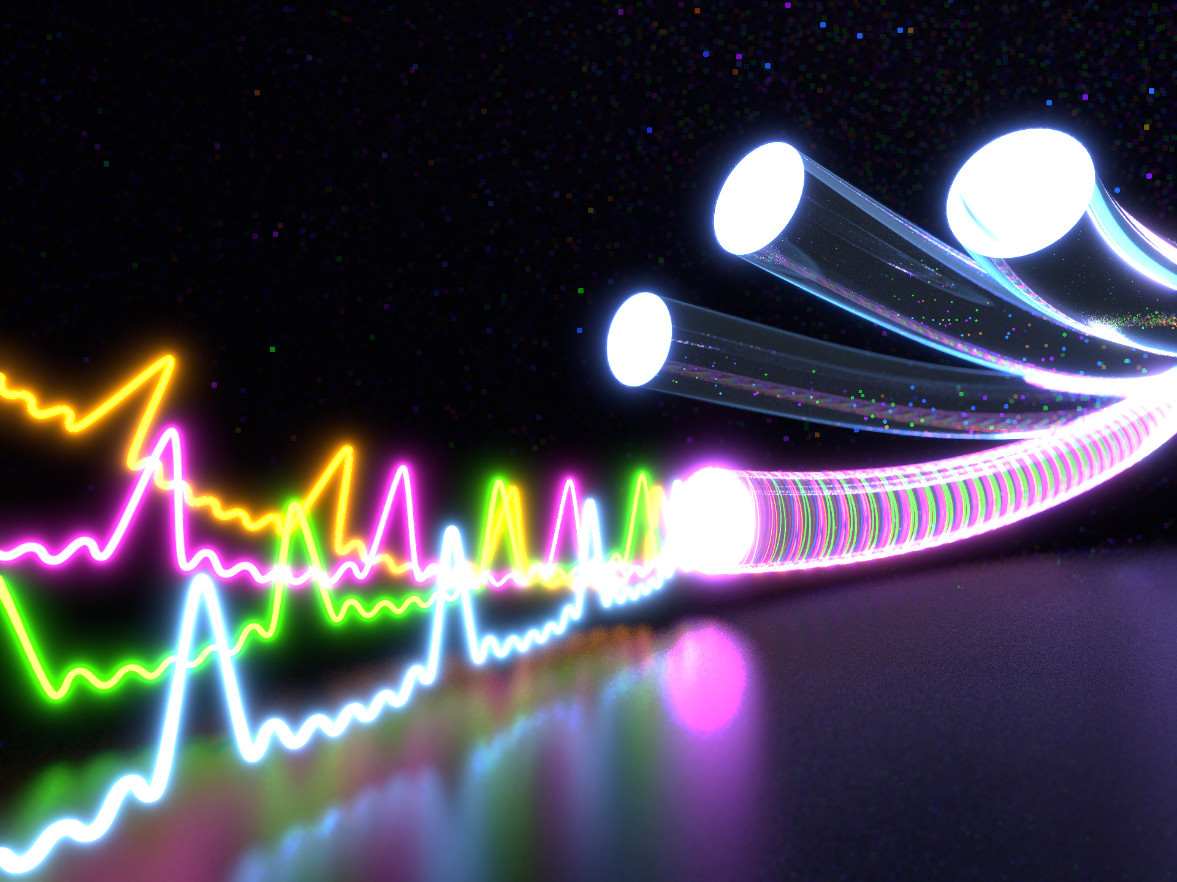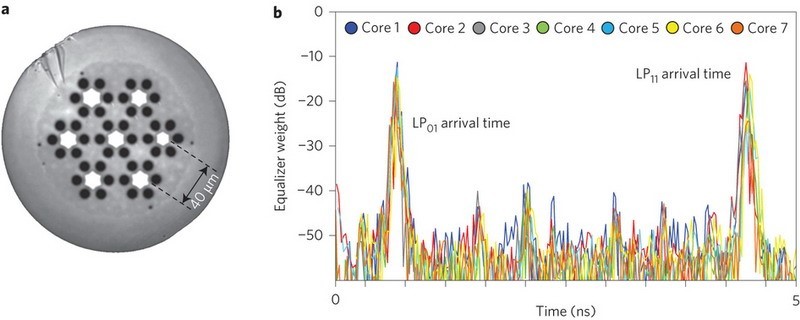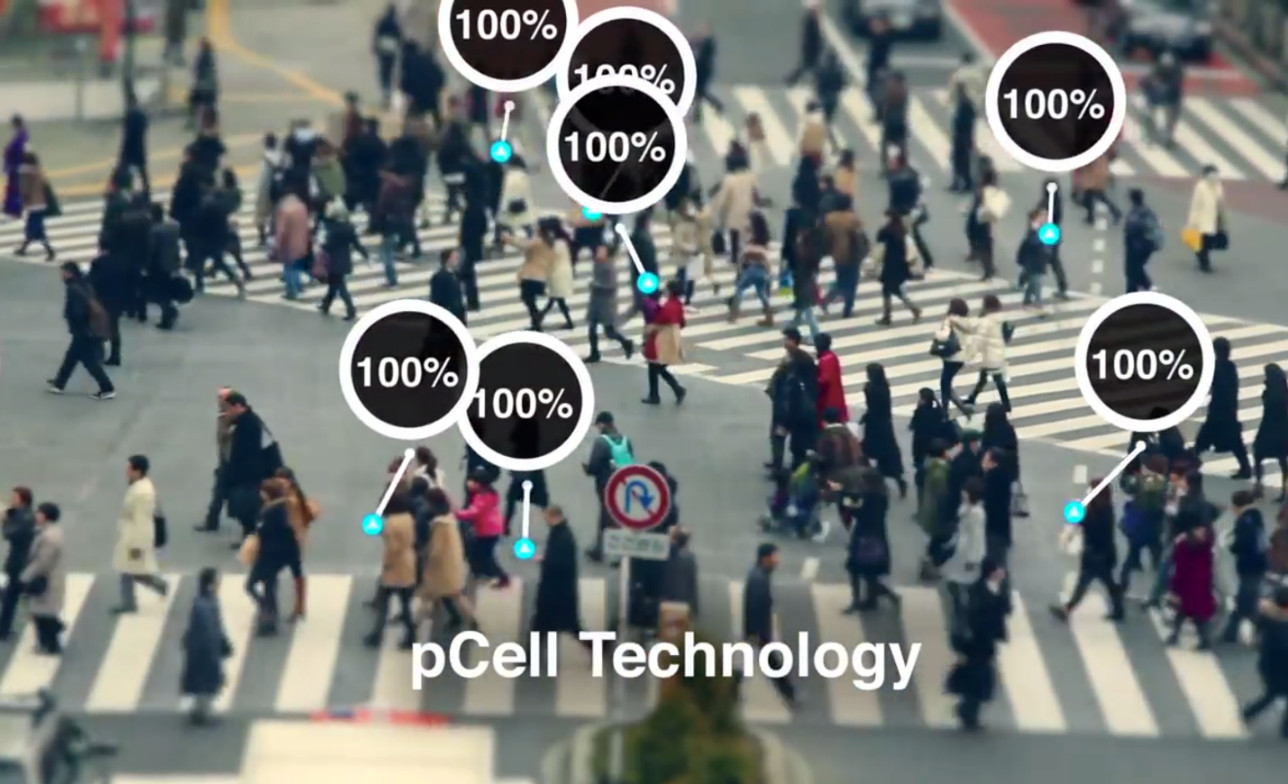Data transfer: fantastic speed and new methods

Illustration of light signals sent through optical fiber ( s )
Do you know what the Internet will always need? In greater bandwidth. Judge for yourselves: the “home” revolution is approaching with 4K-films for hundreds of gigabytes. Behind the wave of video content or in parallel with it, virtual reality will develop. The growth rate is not the only line of research. Today we will tell you about the methods of data transmission, which still look like real fiction, but can nevertheless be realized in the near future.
Good old cable
Researchers from the Danish Technical University in 2014 transmitted data over a single fiber-optic cable at a speed of 43 Tbps. Scientists have used fiber with several cores. Nevertheless, the speed of 100 Tbit / s was achieved in 2011 in two ways : through a fiber-optic core consisting of seven separate fibers, each of which provided a speed of 15.6 Tbit / s; in the second case, the data was “packaged” by using laser beams of a different spectrum, with different amplitudes and phases of radiation — a total of 370 separate beams were used.

')
A scientific group of scientists from Holland and the United States tried to squeeze everything out of a single fiber-optic cable, transmitting data for 1 kilometer at a speed of 255 Tbit / s. The researchers used optical 7-core fiber (in the picture above it is shown on the left). What is the difference with ordinary fiber? Everything is simple, here the light passes in each core, independently of the others. The black dots in the picture are air gaps that isolate the cores from each other. Using this technology, in September 2012, it was possible to achieve a real transmission rate of one petabit per second over a cable with 12 light guide channels over a distance of 52.4 km.
Data light bulb
A few years ago, the optical technology of wireless data transmission Li-Fi (abbreviated from Light Fidelity), in which the receiving-transmitting device, indistinguishable from the ordinary light bulb, flashes at a very high frequency, transmitting information along with the light flux. Reception and transmission of information in Li-Fi is carried out at speeds of about 150 Mbit / s. But the technology of Li-Fi, based on laser LEDs, allows you to increase the speed of information transfer to 100 Gbit / s. The only disadvantage of such a device is that it does not work outside the room.
pCell: myth or reality?

PCell technology should solve the problem of lack of frequencies in the spectrum, allowing each mobile device to work with the entire frequency band provided by the base station, regardless of the degree of congestion. According to the authors of the project from the American startup Artemis Networks, pCell will provide 50 times the speed of current 4G LTE networks using the same frequency range and existing smartphones. Is it possible? At the end of last year, it became known that Nokia Networks will begin testing the pCell technology. It remains for us to wait only for the publication of the results of the study.
LLCD, or why you need a laser

In 2013, the LADEE probe was successfully launched, on which the two-way laser communication system Lunar Laser Communication Demonstration ( LLCD ) was installed . As a result, it was possible to achieve a data transfer rate of 622 Mbit / s from the device to the ground station and 20 Mbit / s from the ground station to the device located at a distance of 385,000 km from the Earth.
Is it possible to use a similar laser link on Earth? Of course. Back in 2011, the results of an experiment on the transmission of data on a directed laser beam with a tremendous speed of 26 Tbit / s over a distance of 50 km were published. And then the difficulty begins with the fact that the beam must be directed. Under urban conditions, this restriction virtually eliminates the advantages of speed.
From brain to brain
One of the most fantastic methods of transmitting information is based on a simple assumption: why do we need additional channels, if in the final analysis we are talking about the exchange of information between one person and another. And what if you immediately connect two brains?
Neuroscientists from the laboratory of Duke University have united the brains of three monkeys into a "local network". Monkeys, using a neural interface and seven hundred electrodes embedded in the motor cortex of the brain, controlled the movement of a virtual hand on a computer screen. Each animal was responsible for managing two of the three axes of arm movement - X and Y, X and Z, Y and Z. The animals learned to share information about the position of the “hand” on the screen and correct its movement.
Body guide
The telecommunications company NTT DoCoMo has developed Human Area Networking technology , in which a small transmitter creates an electromagnetic field around human skin. To remove the signal on another part of the skin, a sensitive optical sensor is used, which receives the signal at a speed of about 10 Mbps. The human body, which passes information through itself, makes it possible to implement interesting technological solutions. How do you like the idea to send a document to print, picking up a flash drive and touching the printer?
Through the whole universe
The team of physicists of the National Accelerator Laboratory. Enrico Fermi (USA) in 2012 proposed a way to transfer data through any object: using neutrinos, a fundamental particle that interacts extremely weakly with matter. Thanks to neutrinos, scientists were able to transmit data through 240 meters of rock - an inaccessible figure for any other wireless technology. However, the data transfer rate was only 0.1 bits per second, but in the future this method can be used to communicate with distant space objects.
With the help of vodka
Yes, there is such an unusual method of data transmission, suitable for use in an environment that impedes the use of electromagnetic waves. The method is based on a molecular system imitating work with the help of volatile chemical compounds. Specialists used vodka vapors to transmit a binary code: the presence of steam - 1, and the absence - 0. The message was sent using a desktop fan to the sensor, analyzing the concentration of alcohol in the air.
Meat communications
At the University of Illinois, we set up an experiment in transmitting ultrasonic signals through animal tissue at speeds up to 30 Mbps - this is a record in the transmission of data through meat!
The method is based on the technology of signal transmission under water. Using a 5 MHz sensor to send a signal through the meat in a tank of water in which there was a hydrophone for its reception, it was possible to transmit a signal at a speed of 20-30 Mbit / s. In the future, this technology will help conduct a live broadcast from the patient's body or update the software of human implants.
Great Soviet Internet
The idea to transfer data using the pipeline came up with another in the Soviet Union. Modern technology has greatly improved the method. Ten years ago, Nethercomm patented Broadband-in-Gas (BiG) technology to transmit a signal over the radio format UWB (Ultra Wide Band) at speeds up to 10 Gbit / s. In the pipeline network, a chain of transponders of a radio signal transmitted in the UWB range is mounted. Due to transponders installed inside the pipe, this technology cannot be used inside water pipes. The radio signal is transmitted inside the existing pipes in parallel with the flow of domestic gas.
The data transfer methods described above will change the world very soon. It is possible that wide channels between the continents will allow to transfer all data centers to one favorable place - to Antarctica, for example, for natural cooling. Communication with distant space objects may become available at high speeds. Normal wired Internet (as well as mobile) will reach an incredible speed.
We do not know for sure exactly how the industry will develop. It is also possible that all the methods described will fade against the background of new research in the coming decade. In any case, the times are changing, which means there will be other incredible data transfer speeds.
Source: https://habr.com/ru/post/283220/
All Articles